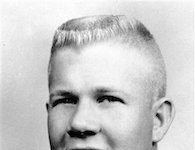On March 24, 1989, the oil tanker Exxon Valdez struck a reef in Alaska’s Prince William Sound, causing 11 million gallons of oil to spill into the water. It is one of the most environmentally damaging oil spills in world history.
Exxon Valdez Strikes Bligh Reef
The oil tanker Exxon Valdez left the Trans Alaska Pipeline terminal in Valdez at 9:12 p.m. on March 23, carrying 53 million gallons of oil. A series of mishaps that night would lead to one of the largest oil spills in modern history.
Under the orders of Captain Joseph L. Hazelwood, the Valdez steered out of its normal shipping lane to avoid icebergs. According to the Alaska Oil Spill Commission report, Hazelwood ceded control of the wheelhouse to Third Mate Gregory Cousins at approximately 11:53; at the same time, Helmsman Harry Claar was replaced by Robert Kagan.
Shortly after midnight, Cousins tried to steer back into the normal shipping lane, but he could not turn the tanker quickly enough. It struck Bligh Reef at approximately 12:04 a.m., puncturing 11 of its cargo tanks. The tanker, stuck up against the reef, began to spill millions of gallons of oil into Prince William Sound.
Government agencies and Exxon sent in crews to contain the spill and clean up the oil, but “spill prevention and response capability in Prince William Sound was fundamentally inadequate,” writes the Exxon Valdez Oil Spill Trustee Council.
An estimated 11 million gallons of oil eventually spilled into the sound, contaminating 1,300 miles of shoreline. The environmental consequences were devastating; the EVOSTC estimates that the spill killed “250,000 seabirds, 2,800 sea otters, 300 harbor seals, 250 bald eagles, up to 22 killer whales, and billions of salmon and herring eggs.”
Though Exxon pledged to thoroughly clean up the spill, oil remains in Prince William Sound. According to the EVOSTC, “while the natural resource damage from lingering oil is largely abating, twenty-five years of research on the Exxon Valdez Oil Spill has demonstrated the surprising persistence of the toxic components of Exxon Valdez oil in the environment.”
Sources in this Story
- Exxon Valdez Oil Spill Trustee Council (Alaska Oil Spill Commission): Details about the Accident
- National Oceanic and Atmospheric Administration: Office of Response and Restoration: Exxon Valdez Oil Spill
- The New York Times: Ship Captain Acquitted of Felony But Is Convicted on Minor Charge
- Alaska Dispatch News: Exxon Valdez: This is it; it’s done
- International Tanker Owners Pollution Federation: Oil Tanker Spill Statistics 2016
Assessing Blame for the Accident
Captain Hazelwood received much of the blame for the accident, especially after reports surfaced that he had been drinking in Valdez bars earlier in the day. But according to the Alaska Oil Spill Commission report, the wreck “represents much more than the error of a possibly drunken skipper: It was the result of the gradual degradation of oversight and safety practices that had been intended, 12 years before, to safeguard and backstop the inevitable mistakes of human beings.”
The National Transportation Safety Board determined that Cousins had not been properly rested before taking control, having had just five or six hours of sleep over the previous 24 hours. It also found that the ship was undermanned, which compromised “watchkeeping safeguards.”
Hazelwood was indicted with a felony charge of second-degree criminal mischief and misdemeanor charges of operating a vessel while intoxicated and of reckless endangerment. He was acquitted of the felony and misdemeanor charges and convicted only of misdemeanor negligence for illegally discharging oil.
Mei Mei Evans, coordinator of the Oil Reform Alliance, said the trial obscured the main issue: “The whole system is culpable, and Exxon and Hazelwood are just two agents in a very complicated and very flawed system of extraction and transportation of petroleum.”
In 1991, Exxon settled charges brought by the state of Alaska, agreeing to pay $3.4 billion in fines and environmental restoration costs. A group of fishermen and native Alaskans later won an award of $2.5 billion in punitive damages from the company, but the U.S. Supreme Court reduced that amount to $507.5 million in 2008.
Reference: Exxon Valdez Oil Spill Trustee Council
The Exxon Valdez Oil Spill Trustee Council traces the history of the incident, provides a map displaying where the oil went, and offers a chart laying out the parties involved in the settlement.
The World’s Worst Oil Spills
Though it is the most famous oil spill in history, the Exxon Valdez spill is not even close to the largest. The International Tanker Owners Pollution Federation ranks the Exxon Valdez 35th on the list of largest spills; the largest, the Atlantic Empress spill of 1979, released more than seven times as much oil as the Exxon Valdez.











